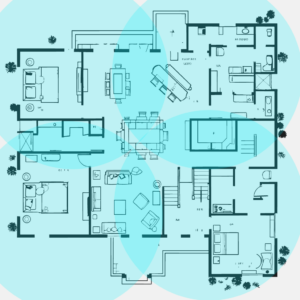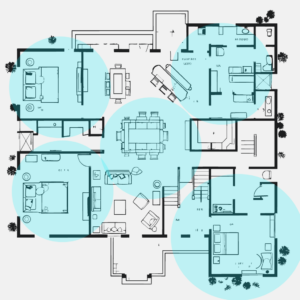As an affiliate, we may earn a commission from qualifying purchases made through links on this site.
With the increase in internet-connected devices in homes, getting full WiFi coverage can be a challenge. Two popular solutions for improving home WiFi are mesh WiFi systems and WiFi extenders.
Contents
What causes WiFi dead zones in the home?
A dead zone refers to an area where your WiFi signal is too weak for devices to connect. There are several factors that can contribute to dead zones forming in your home’s wireless network.
One of the most common causes is the distance from the wireless router. WiFi signals weaken the farther you move away from the router, so areas like basements and other areas in larger homes often end up with a weak or no signal.
Physical barriers are another major culprit. Thick walls, ceilings, and even large appliances can block or degrade the WiFi signal. Additionally, interference from other wireless networks and devices in your home or neighborhood can interfere with your router’s signal and cause connectivity issues.
Older routers may also have lower transmission power or weaker antennas that don’t broadcast as far.
What is a Mesh WiFi System?

A Mesh WiFi system comprises a network of multiple wireless access points that collaborate to create complete WiFi coverage. Multiple Mesh WiFi routers are strategically placed around the home to ensure WiFi access across your entire home.
Unified Network
Mesh Wifi networks work on a unified network name and password. With this setup, your devices can effortlessly transition between access points as you move from room to room. Picture this: you’re streaming your favorite show in the living room, and as you wander into the kitchen for a snack, your phone seamlessly switches between mesh points, never missing a beat. No signal drops, no frustration – just pure uninterrupted connectivity.
Optimized Data Flow
Mesh routers aren’t just smart; they’re genius. They communicate with each other to determine the fastest data path back to the main router. This dynamic routing ensures that your data travels the optimal route, maintaining blazing-fast WiFi speeds.
Set-Up Made Simple
Gone are the days of complex installations. Mesh WiFi systems offer user-friendly mobile apps that guide you through the setup process, making it a breeze for tech-savvy users and novices alike. Plus, robust parental controls give you the power to manage network access and content with ease.
A Buffer-Free, Lag-Free Paradise
Investing in a Mesh WiFi system is your ticket to an internet utopia, free from the agony of buffering, lag, and those dreaded dead zones. With whole-home coverage and simplified management, mesh WiFi systems are the ultimate choice for crafting a wireless network that dreams are made of.
What is a WiFi Extender?

A WiFi extender is a device designed to receive the wireless signal from your router and then amplify and rebroadcast it into areas where the signal is weak or non-existent. Think of it as a beacon of connectivity, extending the overall range and coverage of your home’s wireless network.
Ease of Setup
One of the standout features of WiFi extenders is their user-friendly setup process. These compact devices seamlessly plug directly into a standard wall outlet, giving you the flexibility to position them anywhere within range of your router’s signal.
The installation process typically involves three simple steps:
- Plug and Play: As mentioned, plug the extender into a suitable outlet.
- Connect to Your Network: You have two convenient options here. You can either use WPS (Wi-Fi Protected Setup) for a quick and secure connection or opt for a browser-based setup, which offers more customization.
- Strategic Placement: Position the extender in the problem area where WiFi coverage is lacking. This could be your backyard, upstairs rooms, garage, or any spot in your home that needs a connectivity boost.
Seamless Integration
Once your WiFi extender is configured, it becomes an integral part of your network infrastructure. Devices in the extended area can connect to the extender’s unique SSID (Service Set Identifier), which then relays that connection back to the primary router wirelessly. This ingenious relay system effectively expands your network’s reach into previously unreachable spaces.
Cost-Effective Solution
One of the most appealing aspects of WiFi extenders is their affordability. They offer a straightforward and budget-friendly way to enhance your WiFi performance without the need for costly router hardware upgrades or extensive rewiring.
If money isn’t and issue then the Mesh WiFi systems are the superior choice for delivering seamless whole-home WiFi coverage. Their robust features and ability to eliminate dead zones make them worth the investment for most homes. WiFi extenders are a cheaper alternative but may sacrifice performance and experience.





